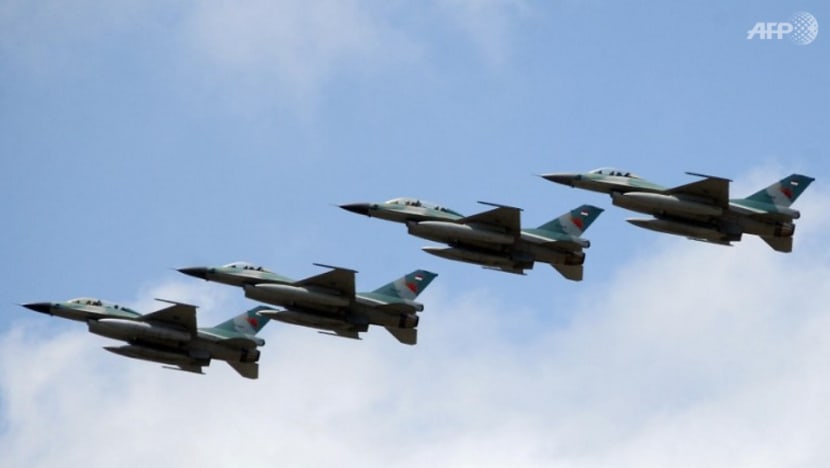commentary Commentary
Commentary: Questions arise over Indonesian military’s maintenance programmes after submarine sinking
Many modern militaries operate old platforms. The greater challenge is whether maintenance programmes have kept up, says defence analysts Mike Yeo.

Naval officers pay their respects during a remembrance ceremony for the crew of the KRI Nanggala. (Photo: AFP/Juni Kriswanto)
MELBOURNE: The sinking of the 40-year-old Indonesian submarine and the loss of Indonesian Navy personnel on board in waters north of Bali last week have caused reverberations in Indonesia as it grapples with the devastating loss.
Among the questions asked in the wake of the incident is the viability of continuing to operate ageing defence platforms – and more broadly, how the recurrence of such a tragedy can be prevented when the country had recently commissioned three more submarines over the past five years.
More voices are pushing for a sister submarine KRI Cakra to decommissioned, or at least grounded until its seaworthiness is verified.
This is despite analysts rightly pointing out that Indonesia, with its vast land area, territorial waters and airspace, needs a certain mass of defence platforms yet has to strike a balance due to a limited budget.
READ: Commentary: Indonesia submarine tragedy exposes painful realities of international rescue operations
INDONESIA’S OLD PLATFORMS
Analysts have also pointed out it makes little fiscal sense for armed forces to withdraw billion-dollar equipment before their full service life has been reached unless there are compelling reasons for doing so.
Investigations into the causes of the submarine sinking may shed more light, but for now, no new reason has surfaced. And so the Indonesian military will continue operating older, even second-hand platforms to ensure the archipelagic nation has sufficient assets to ensure its defence.
These include a fleet of former East German naval vessels procured and refurbished in the 1990s, British-built Hawk trainers and light attack jets already in service for over three decades.

The Indonesian military also operates the Lockheed-Martin C-130 Hercules transport aircraft, some of which are over 60 years old.
It has also in recent years acquired former US Air Force F-16 fighter jets upgraded to newer standards, and looked at used Eurofighter Typhoon fighters withdrawn from use by Austria, as Indonesia seeks to modernise its air force and broaden its ability to defend it vast airspace.
A MIX OF PLATFORMS
This is not a practice confined to larger or cash-strapped countries. Almost every military has in its inventory a mix of new and older platforms, some on the verge of retirement and replacement.
Indeed, Singapore too is no stranger to this practice. The Challenger-class submarines operated by the Republic of Singapore Navy’s were acquired from Sweden, refurbished and upgraded for purpose.
The four were already 30 years old when acquired by the RSN in the late 1990s, two of which are still in service.
READ: Commentary: Meet the Republic of Singapore Navy’s new poison shrimp. They even call it 'Invincible'
Even the RSAF’s fleet of F-16 fighter jets, currently being upgraded to keep relevant, will only be retired from the 2030s, which will mean the oldest jet will be around 35 years old at that point.
Part of this strategy sometimes involves purchasing second-hand defence platforms. Beyond the low initial acquisition costs, used defence equipment comes with user history, so a buyer is less likely to be surprised by unknown quirks and issues with operating the acquired system if they completed due diligence with the former operator.
They would know the failure rate of individual parts or subsystems based on the former operator’s history of maintenance, and get a clearer idea of what spares need to be stocked up on and what areas to look out for when carrying out maintenance.

Buying second-hand equipment gives a country a “ready to go” capability, such that urgent requirements can be quickly met as opposed to having to wait for a new fighter jet, tank or warship to be designed and built, which could take years.
HIGHER MAINTENANCE COSTS AS PLATFORMS AGE
The costs of operating and maintaining platforms will naturally creep up as they age. For these reasons, such equipment must be diligently maintained. Serviceability could suffer otherwise, imposing further, additional costs on militaries.
This discussion over maintenance is relevant where KRI Nanggala, a Cakra-class Type 209 submarine, was launched some 40 years ago after the Indonesians purchased it first-hand from Germany.
Indonesian media outlets have reported that the submarine had missed a scheduled maintenance period in 2020 which has been blamed by some quarters on the COVID-19 pandemic.
While it is still not clear that the missed maintenance cycle is connected to the sinking, the investigation into this event will no doubt be looking at this angle after investigators have said they will examine the impact of age on the submarine.
READ: Commentary: Submariners face huge challenges underwater - where there's no margin for error
ROBUST PROGRAMME NEEDED
One of the main challenges for militaries when it comes to operating older equipment is to keep these systems going while ensuring that they remain fit-for-purpose in the face of obsolescence. As equipment ages, a robust and timely maintenance programme will become more important, including the use of preventive maintenance to catch potential issues before they happen.
This will involve more extensive inspections carried out more frequently, particularly for signs of corrosion or metal fatigue, in concert with data gleaned from the manufacturer’s or other operators’ experiences with similar systems where possible.
Modern tools for equipment sustainment should be explored to see if they can be used to keep the serviceability of older systems at sufficiently high levels.
These include the use of data-driven performance-based logistics models, which can result in increased serviceability rates, maintenance efficiencies and lower costs throughout the platform's life cycle.
The Royal Australian Air Force (RAAF), for example, has contracted Airbus Australia to maintain its fleet of Lockheed-Martin C-130J Hercules transport aircraft under a performance-based logistics support contract since 2009.

Then Australian Defence Minister Christopher Pyne estimated that the contract extension signed in 2018 would save A$10 million (US$7.8 million) between 2019 and 2024
The RAAF, for its part, has reported that this sustainment model has improved the availability of the 12-aircraft fleet, which are just over 20 years old, by one additional aircraft on average over an 18 month period.
With this, the Australians can carry out more missions with the aircraft, to transport personnel, supplies and equipment to support Australian military operations overseas, training, and humanitarian relief missions to the South Pacific.
Upgrade programmes primarily to ensure platforms remain relevant can also improve the serviceability of older equipment, with the replacement of specific parts that break down less often.
Another good example is Singapore’s upgrade to its fleet of 70 second-hand A-4 Skyhawk fighter-bombers in the 1990s. The old and increasingly unreliable engines of the aircraft, most of which had taken part in the air war over Vietnam in the 1960s while serving with the US Navy and Marine Corps, were replaced with a modern and more powerful substitute.
The move not only significantly improved the performance of the jet, but also tackled directly a safety concern as it effectively ended a spate of RSAF Skyhawk crashes in the mid-1980s brought about by engine failures.
More broadly, the upgraded jets could continue to serve the RSAF until the last aircraft were retired in 2012, roughly 50 years after they rolled off the factory floor.
READ: Commentary: The road to getting the F-35s up and ready for Singapore
READ: Commentary: Noisy RSAF aircraft and annoyed residents - some compromises are needed
FOCUS ON SERVICEABILITY RATHER THAN AGE OF PLATFORMS
It is fiscally responsible for militaries to continue operating older equipment as long as it is operationally viable to do so. They should extract as much value as possible out of expensive defence equipment and not take fiscal prudence lightly.
However, to do so requires a robust programme to ensure serviceability, safety, efficacy and value-for-money.
If anything, this KRI Nanggala tragedy might highlight how much the Indonesian Navy needs to devote more funding and attention to maintenance. This is the unglamorous side of national defence compared to shiny new equipment, but is one area that cannot be neglected.
Mike Yeo is the Asia reporter for US-based defence publication Defense News.














